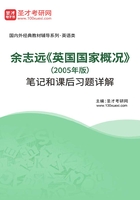
第7章 政府和行政管理
7.1 复习笔记
Ⅰ.The Monarchy
Ⅱ.Parliament
1.The House of Lords
2.The House of Commons
(1) Parliamentary Electoral System
(2) The Political Party System
(3) Other Aspects of the House of Commons
Ⅲ. The Cabinet and Ministry
Ⅳ.The Privy Council
Ⅴ. Government Departments and the Civil Service
Ⅰ.The Monarchy
1. Although the seat of the monarchy is in Britain, the Queen is also head of state of a number of Commonwealth states such as Australia, Canada, and New Zealand.
2. The Queen is the symbol of the whole nation.
3. The Queen is the centre of much of the nation’s ceremonial, by ancient tradition.
Ⅰ.君主制
1.尽管君主制的所在地是英国,女王也是英联邦国家的首脑,比如澳大利亚,加拿大和新西兰。
2.女王是整个国家的象征。
3.传统上讲,女王是国家大多数仪式的中心。
Ⅱ.Parliament
Parliament consists of the Sovereign, the House of Lords and the House of Commons. A Parliament has a maximum duration of five years,
1.The House of Lords
The House of Lords is made up of the Lords Spiritual and the Lords Temporal. The House is presided over by the Lord Chancellor.
Ⅱ.议会
议会由君主,上议院和下议院组成。议会的最长任期是五年。
1.上议会
上议会由神职贵族和世俗贵族组成。议会由贵族大臣主持。
2.The House of Commons
The House of Commons is elected by universal adult suffrage and consists of 651 Members of Parliament (MPs).
(1) Parliamentary Electoral System
①A member of the House of Commons are elected either at a General Election, or at a by-election held when an MP dies or resigns.
②For electoral purposes Britain is divided into constituencies, each of which returns one member to the House of Commons.
2.下议院
下议院由成人普选产生,共有651名成员。
(1) 议会选举制度
①下议院的成员在普选,或在议员去世或辞职时的递补选举中产生。
②英国分为很多选区,每个选区有一名下议院议员。
(2) The Political Party System
①The party which wins sufficient seats at a General Election to command a majority of supporters in the House of Commons usually forms the Government.
②The party which wins the second largest number of seats becomes the official Opposition, with its own leader and “shadow cabinet”.
(2) 政党制度
①在普选中赢得足够席位,且获得下议院多数支持者的政党通常会组建政府。
②赢得第二大席位支持者的政党成为反对党,由领袖和“影子内阁”组成。
(3) Other Aspects of the House of Commons
①In the House of Commons, all speeches are addressed to the Speaker. The Speaker is a member who is acceptable to all shades of opinion in the House.
②Most Bills are measures relating to public policy.
(3) 下议院的其他方面
①在下议院,所有演讲都由议长主持。议长对所有观点保持中立。
②大多数议案都是与公共政策有关的措施。
Ⅲ. The Cabinet and Ministry
1. Her Majesty’s Government is the body of ministers responsible for the conduct of national affairs. The Prime Minister is appointed by the Queen.
2. Ministers are appointed by the Queen on the recommendation of the Prime Minister.
Ⅲ.内阁部门
1.政府是由处理国家事务的各个部长组成。首相由女王任命。
2.部长是由首相推荐,女王任命产生。
Ⅳ.The Privy Council
1. Today its role is largely formal, advising the sovereign to approve certain government decrees and issuing royal proclamations.
2. The Privy Council is presided over by the Lord President of the Council.
Ⅳ.枢密院
1.现在,枢密院的职责大多数是礼仪性的,比如建议君主批准某些政治法令和发行皇家宣言。
2.枢密院由枢密院议长主持。
Ⅴ. Government Departments and the Civil Service
1. Government departments and their agencies are the main instruments for implementing government policy.
2. The government departments are staffed by members of the Civil Service.
3. Responsibility for central coordination and management of the Civil Service is divided between the Treasury and the Cabinet Office.
Ⅴ.政府部门和行政机构
1.政府部门是实施政府政策的主要机构。
2.政府部门的成员是行政机构的职员。
3.行政机构的协调和管理职责主要分布在财政部和内阁办公室。
Ⅵ.Local Government
1. There are two main tiers of local authority throughout England and Wales: counties and the smaller districts.
2. The local authorities run many of the public services. County councils provide large-scale services, while district councils are responsible for the more local ones.
Ⅵ.地方政府
1.英格兰和威尔士主要分为两级:郡和更小的区。
2.地方政府办理很多公共服务。郡委员会提供大范围的服务,而区委员会负责更多的地方服务。